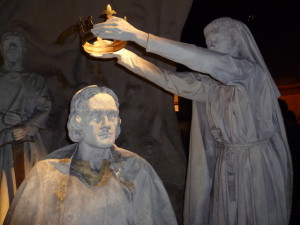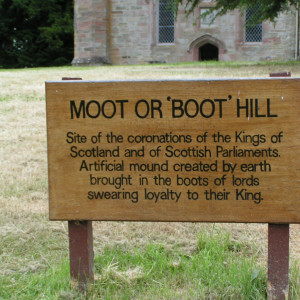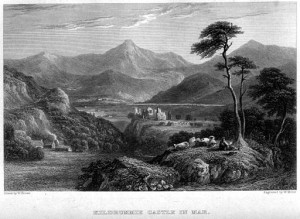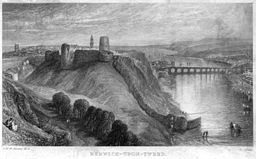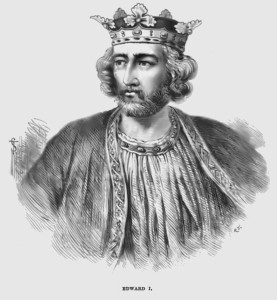Isabel, Countess of Buchan
It sounds like something out of a fantasy horror story – a young woman imprisoned in a cage hanging off the sides of a castle wall, and in some ways it is. Much of her story is shrouded in myth. So what really happened to the Countess of Buchan, Isabel MacDuff Comyn?
The daughter of Colban, Earl of Fife, Isabel was born around 1270. She married John Comyn, the seventh earl of Buchan. Following his capture after the battle of Dunbar, he was required to live in England. In 1297 he was sent back to Scotland while Isabel stayed in England to manage his estates.
Although he submitted to Edward, the earl of Buchan initially was against English interference in Scottish affairs, but the murder of his relative (another John Comyn) by Bruce pushed him firmly into the English camp. Little is known of Isabel’s actions at this time, but she soon would come to the forefront of Scottish history.
In 1306, Robert the Bruce was crowned king at Scone (pronounced Scoon), the traditional place of coronation for Scottish kings. He was unable to be crowned upon the Stone of Scone because it had been seized by Edward I and was resting in Westminster Abbey. However, something else beside the Stone of Destiny was missing. The earls of Fife had long been the ones to place the coronet upon the new king’s head. However, the current earl of Fife had spent his minority in England and had no desire to crown Robert the Bruce as king. His aunt, Isabel, traveled to Scone to in order to perform the ceremony. She reached Scone late, but was able to crown Robert Bruce on 25 March. (Some sources say 27 March.)
Having opposed her husband and Edward I in this manner, Isabel had no safe home in which to return. She, with the royal ladies, including Bruce’s wife and sisters, were first moved to Kildrummy Castle. Slanderous rumors soon arose that the countess was Robert’s mistress, but it is doubtful that he would have sent her off with his wife if this was the case. Eventually the women made their way north, perhaps towards Orkney. However, they were intercepted at St Duthac’s Church in Tain.
Robert’s wife was placed in honorable captivity and his daughter was placed in a convent. One of his sisters, Christian, wife of Christopher Seton, was also placed in a convent. His other sister, Mary, and Isabel did not escape so easily. Mary was placed in a cage at Roxburgh Castle, while Isabel suffered a similar fate at Berwick Castle.
Caged
According to Francis Palgrave, Letters of Privy seal were sent to the Chamberlain of Scotland that he should ‘make a cage in one of the turrets of the castle’. One chronicler described her cage as a ‘little house of timber…the sides latticed so that all there could gaze on her as a spectacle’. The cage was to be strengthened with iron so that she could not escape, and English women were appointed to care for her. She was not allowed to speak to anyone other than these women.
The cage, which included a privy, was ‘to be so constructed that the Countess is to have therein all conveniences of a handsome chamber’, according to Palgrave, and ‘…the same is to be so safely and surely ordained that no peril may happen concerning the care of the Countess, and that he who so has the care of her, may answer body for body, and have due allowance of all the costs which he shall incur…’
Although some historians still believe that she was out in the open, I find that doubtful since Edward’s instructions clearly stated that she was to be inside and the castle’s custodian would have to answer for anything that happened to her. Also, if she was not allowed to speak to anyone, why would she be placed outside where access to her would be easier? However, it is still a possibility and sometimes legends have a basis in fact. Inside or outside, being forced to live in a cage would still be a horrible punishment.
In 1310, Isabel was released from her cage and placed in the Carmelite friary in Berwick. It wasn’t until April of 1313 that the courageous Countess of Buchan was finally released into the custody of Henry de Beaumont, husband of Alice Comyn, her niece by marriage. After this she slips into the mists of history.
Sources:
Andrew McDonald, ‘Macduff family, earls of Fife (per. c.1095–1371)’, Oxford Dictionary of National Biography, Oxford University Press, 2004 [http://www.oxforddnb.com/view/article/50328, accessed 6 March 2015]
Calendar of Documents Relating to Scotland, 1307-1357 [accessed 6 March 2015 https://play.google.com/books/reader?id=KpfRAAAAMAAJ&printsec=frontcover&output=reader&hl=en&pg=GBS.PR1]
Fiona Watson, ‘Buchan , Isabel, countess of Buchan (b. c.1270, d. after 1313)’, Oxford Dictionary of National Biography, Oxford University Press, 2004 [http://www.oxforddnb.com/view/article/54144, accessed 6 March 2015]
Fiona Watson, ‘Comyn, John, seventh earl of Buchan (c.1250–1308)’, Oxford Dictionary of National Biography, Oxford University Press, 2004 [http://www.oxforddnb.com/view/article/6047, accessed 6 March 2015]
Palgrave, Francis. Documents and Records Illustrating the History of Scotland; Trasactions Between the Crowns of Scotland and England. 1837 [accessed 6 March 2015 https://play.google.com/books/reader?id=7ew9AAAAcAAJ&printsec=frontcover&output=reader&hl=en&pg=GBS.PP7]
Kristie Dean is the author of The World of Richard III, currently available at bookstores and Amazon.
